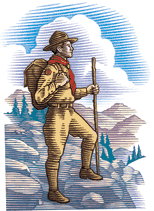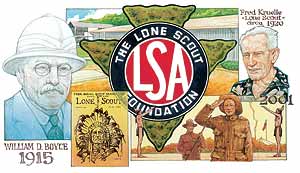![]() September 2002
September 2002


Where the Past Is Ever Present
By Robert Peterson
Illustration by Joel Snyder
The museum at a North Carolina council Scout camp commemorates the Lone Scouts of America.
The cliché "labor of love" is tossed around freely to describe acts as varied as Mother Teresa's mission and the volunteer services of a Cub Scout den leader. If a building can embody the idea behind the cliché, I have a candidate.
It is the museum and archives of the Lone Scouts of America (LSA) at Camp John J. Barnhardt, the Scout camp of the Central North Carolina Council near New London, N.C. The museum was built more than 30 years ago by scores of volunteer laborers, then in their 60's, who had been members of the LSA between 1915 and 1924.

In the latter year, the LSA was absorbed by the Boy Scouts of America, to the consternation of most Lone Scouts. They loved Lone Scouting, which had been founded in 1915 by William D. Boyce, a Chicago publisher who had earlier, in 1910, incorporated the BSA. [See "The Man Who Got Lost in the Fog," The Way It Was, Scouting, October 2001.]
Boyce's idea was to offer a Scouting program to boys in isolated rural areas who could not find a troop to join. The program was hugely successful, attracting city kids as well as farm boys, some of whom were already Boy Scouts.
No adult leaders
One attraction was that there were no adult leaders; Lone Scouts were on their own.
"We didn't have any adult leadership; we had to create our own initiative," remembered 99-year-old Frederick R. Kruelle during the annual Lone Scouts reunion in October 2000. At that time, Kruelle (who died last December) was acknowledged as one of the oldest living Lone Scouts. At the 2001 National Scout Jamboree, he spent a day sharing stories of Lone Scouting with Scouts in attendance.
Members of the LSA worked on Lone Scouting's advancement plan without adult supervision. They were on their honor when they wrote to the Chicago "longhouse" to report to Chief Totem W. D. Boyce that they had completed requirements for advancement.
Lone Scouts looked forward to receiving a weekly—later monthly—magazine called Lone Scout. The lively publication welcomed contributions from readers, and thousands of boys and young men (Lone Scouting had no age limit) sent news reports on the doings of their tribes (patrols), fiction stories, cartoons, and photographs. Lone Scout was the inspiration for hundreds of "tribe papers" published by mimeograph and primitive printing press by individual Lone Scouts and tribes. The magazine was also the spawning ground for thousands of future writers, editors, and printers.
A lodge for remembering
The museum, called Lone Scout Memory Lodge, is an attractive Indian-style longhouse sided with pink Salisbury granite. The stone, like many other components of the structure, was donated. A professional stonemason and carpenter supervised, but the labor was furnished mainly by North Carolinians who had been members of the Catawba and Beaver tribes of the LSA.
Fred Kruelle became a Lone Scout in 1916 in his hometown of Lauraville, Md., soon after the organization was founded. Most Lone Scout tribes had only five or six members, but his Lone Eagle tribe boasted about 25.
"We would camp in the woods near town," he remembered. "There was a stream we would dam up to make a pool. We also held fairs, or carnivals, as fund-raisers. For years we met on the second floor of a barn. I think dues were 5 cents a week—and that was a big deal then."
Kruelle was the only pre-merger Lone Scout who attended the annual Memory Lodge reunion in 2000. The dozen other attendees included some Lone Scouts who joined after the BSA took over the program, widows of Lone Scouts, or sons who may never have been in Scouting at any level but who loved the historical aspects of Lone Scouting.
One of them was Victor P. (Pat) Crain, a history buff, whose father, Orin, had earned the LSA's top honor—Supreme Scout—during the early 1920s. He was one of only 123 who received that title.
Pat Crain, who was never a Scout (either Lone or Boy), said that when he first visited Memory Lodge in 1996, "I was awestruck." He is now the editor of the Memory Lodge Journal, the quarterly newsletter of the Lone Scout Foundation, which maintains the museum. (Crain succeeded Fred Kruelle as editor.)
Memory Lodge houses thousands of items of Lone Scouting memorabilia given by men who had lovingly preserved their membership pins, advancement recognitions, handbooks, badges, copies of Lone Scout and tribe publications, parts of the Lone Scout uniform, and Scoutcraft items they had made.
The museum also has portraits and a bust of the LSA founder Boyce and some of his writings. The archives room contains bound volumes of Lone Scout magazine and all of the handbooks produced by the LSA.
In a separate room, there is a collection of handicrafts and regalia of Native Americans, reflecting Lone Scouting's focus on Indian lore. (The symbol of Lone Scouting, which appeared frequently in Lone Scout, was a solitary Indian with arms outstretched, palms down, in a gesture of peace.) Adjacent to Memory Lodge is a print shop museum displaying the old presses and type fonts that were staples of Lone Scouting's tribe paper production.
Memory Lodge is underused, considering its appeal. Each fall a reunion is held for LSA members, their widows and children, and a handful of more recent Lone Scouts.
Each spring, volunteers hold a work week there to spruce things up, and during the Christmas holidays, there is a party for Cub Scouts, sponsored by the Central North Carolina Council. Trustee and camp ranger Joseph Copple said that about 800 of the 1,100 summer campers at Barnhardt last year visited Memory Lodge. He welcomes tourists who want to see the display. Arrangements for a visit can be made by calling Copple at (704) 422-3837 or faxing him at (704) 422-6017.
A dwindling band
The original Lone Scouts of America are a dwindling band, a last man's club. But if the Lone Scout Foundation has its way, the LSA and Memory Lodge will not be forgotten. Foundation Chairman Andrew C. Tainter III said that he and Pat Crain are working on plans to offer associate memberships in the foundation for a $5 annual fee. (Andy Tainter was a Lone Scout as a member of the Boy Scouts of America from 1949 to 1953.)
For the year 2000, the foundation took in between $2,000 and $3,000 in contributions and earned about $400 from sales of postcards at Memory Lodge. That's enough to pay the insurance and electricity bills, Andy Tainter said, but not enough for a comfortable endowment.
Anyone who wants to help ensure the future of Memory Lodge and its treasures can send a contribution made out to The Lone Scout Foundation to Andrew C. Tainter III, Chairman, Lone Scout Foundation, 57 Confederate Way, Stafford, VA 22554-5175.
Robert W. Peterson is the author of The Boy Scouts: An American Adventure. He described the early days of Lone Scouting in more detail in The Way It Was column in the October 1985 issue of Scouting magazine.
Lone Scout Alumni Never ForgotTwo loosely organized groups kept the Lone Scout flame burning decades after the Lone Scouts of America was absorbed by the BSA in 1924. One was the Elbeetian Legion, formed in 1927 by Charles J. Merlin of Hudson Heights, N.J. As a boy, he had published a tribe paper called the Lone Beaver Tribune. As an adult, he mailed out a monthly newsletter called Elbeetee for more than six decades until his death in 1995. The Elbeetian Legion had no officers, dues, or rules. In fact, Charles J. Merlin was the legion. At its height, the legion's mailing list contained about 1,000 names. The list was crucial to building Memory Lodge because it was used to solicit persons likely to give money or donate materials. (Nearly all the project's volunteer laborers were Elbeetians.) A second alumni group was the Lone Indian Fellowship. It was formed in 1926 by Ernst Grube of Sheboygan, Wis., who kept members in touch by publishing the monthly Lone Indian until his death in 1994. Both the Elbeetian Legion and Lone Indian Fellowship held annual reunions for many years. — R.W.P. |
September 2002 Table of Contents
Copyright © 2002 by the Boy Scouts of America. All rights thereunder reserved; anything appearing in Scouting magazine or on its Web site may not be reprinted either wholly or in part without written permission. Because of freedom given authors, opinions may not reflect official concurrence.
| The Boy Scouts of America | http://www.scouting.org |